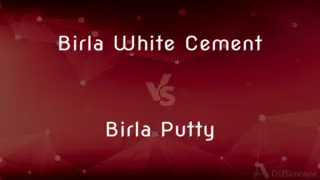Granulated Sugar vs. Powdered Sugar — What's the Difference?
By Tayyaba Rehman — Published on November 7, 2023
Granulated Sugar is coarse with visible grains, while Powdered Sugar is finely ground with a powdery consistency.

Difference Between Granulated Sugar and Powdered Sugar
Table of Contents
ADVERTISEMENT
Key Differences
Granulated Sugar, as the name suggests, has a granulated texture. It's the most common sugar used in households and cooking. On the other hand, Powdered Sugar is finely ground sugar with a smooth and powdery texture.
Granulated Sugar often serves as the primary sweetener for baked goods, beverages, and many other recipes. Conversely, Powdered Sugar is commonly used for icing, glazes, and dusting desserts because of its fine consistency.
Both Granulated Sugar and Powdered Sugar are derived from the same source – sugar cane or sugar beets. However, the difference lies in their processing. While Granulated Sugar retains its crystalline form, Powdered Sugar undergoes additional grinding.
Granulated Sugar dissolves relatively slower in liquids compared to Powdered Sugar. This is because the larger granules take more time to break down. Powdered Sugar, with its tiny particles, dissolves quickly, making it ideal for certain applications like frostings.
In terms of measurement, Granulated Sugar and Powdered Sugar are not always interchangeable in recipes. This is due to the difference in their particle sizes. For instance, a cup of Granulated Sugar does not equate to a cup of Powdered Sugar in weight or volume.
ADVERTISEMENT
Comparison Chart
Texture
Coarse with visible grains
Finely ground with a powdery consistency
Primary Use
Sweetening baked goods, beverages, etc.
Icing, glazes, dusting desserts
Solubility
Dissolves slower in liquids
Dissolves quickly in liquids
Interchangeability in Recipes
Not always interchangeable
Requires adjustments in volume/weight
Derived From
Sugar cane or sugar beets
Same, but undergoes additional grinding
Compare with Definitions
Granulated Sugar
Standard sugar used for sweetening purposes.
The cake recipe called for a cup of Granulated Sugar.
Powdered Sugar
Finely ground sugar used for icing and dusting.
She sprinkled Powdered Sugar on the freshly baked donuts.
Granulated Sugar
Regular white sugar with distinct grains.
He stirred the Granulated Sugar into the cookie dough.
Powdered Sugar
Sugar with added cornstarch to prevent clumping.
The frosting was made smooth with the addition of Powdered Sugar.
Granulated Sugar
Most common form of household sugar.
She prefers Granulated Sugar over brown sugar in her recipes.
Powdered Sugar
Also known as confectioners' sugar.
She sifted the Powdered Sugar before adding it to the mixture.
Granulated Sugar
Crystalline sweetener derived from sugar cane/beets.
Granulated Sugar is stored in a container on the kitchen shelf.
Powdered Sugar
Sugar processed into a soft, powdery consistency.
He whipped up a glaze using Powdered Sugar and lemon juice.
Granulated Sugar
Coarse-textured sugar used in daily cooking.
She added a teaspoon of Granulated Sugar to her coffee.
Powdered Sugar
Dissolves quickly due to its fine texture.
To sweeten the whipped cream, she stirred in some Powdered Sugar.
Common Curiosities
Do Granulated Sugar and Powdered Sugar taste different?
Both are sweet, but the difference lies in their texture, not taste.
What is the primary difference between Granulated Sugar and Powdered Sugar in texture?
Granulated Sugar is coarse with visible grains, while Powdered Sugar has a powdery consistency.
Why is cornstarch added to Powdered Sugar?
Cornstarch prevents Powdered Sugar from clumping and absorbing moisture.
Can I make my own Powdered Sugar from Granulated Sugar?
Yes, by grinding Granulated Sugar in a blender until it's powdery.
Why is Powdered Sugar often used for dusting desserts?
Its fine consistency allows for a light, even layer over desserts.
Can I substitute Granulated Sugar for Powdered Sugar in recipes?
Not always, as they have different volumes and textures; adjustments might be needed.
Is the sweetness level the same for both Granulated Sugar and Powdered Sugar?
Yes, but due to texture differences, they might impart a different mouthfeel.
Why is Powdered Sugar smoother in frostings compared to Granulated Sugar?
Its fine texture ensures a smooth consistency without grittiness.
Can I use Granulated Sugar in place of Powdered Sugar in frosting?
It's best to use Powdered Sugar for frosting due to its fine texture; Granulated Sugar may leave a gritty texture.
Can I use Powdered Sugar for coffee or tea?
Yes, it'll dissolve quickly, but Granulated Sugar is more commonly used.
Are there any other names for Powdered Sugar?
Yes, it's also known as confectioners' sugar or icing sugar.
How is Granulated Sugar typically processed?
It's processed from sugar cane or sugar beets and crystallized.
Which sugar dissolves faster: Granulated Sugar or Powdered Sugar?
Powdered Sugar dissolves faster due to its fine particles.
How do Granulated Sugar and Powdered Sugar react when baked?
Granulated Sugar can provide structure in baking, while Powdered Sugar gives a tender crumb.
Is there a health difference between Granulated Sugar and Powdered Sugar?
Both are forms of sucrose and have similar caloric content, but Powdered Sugar contains a small amount of cornstarch.
Share Your Discovery

Previous Comparison
Family Name vs. Surname
Next Comparison
Birla White Cement vs. Birla PuttyAuthor Spotlight
Written by
Tayyaba RehmanTayyaba Rehman is a distinguished writer, currently serving as a primary contributor to askdifference.com. As a researcher in semantics and etymology, Tayyaba's passion for the complexity of languages and their distinctions has found a perfect home on the platform. Tayyaba delves into the intricacies of language, distinguishing between commonly confused words and phrases, thereby providing clarity for readers worldwide.














































